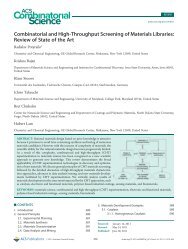Effect of substrate orientation on lattice relaxation of epitaxial ...
Effect of substrate orientation on lattice relaxation of epitaxial ...
Effect of substrate orientation on lattice relaxation of epitaxial ...
Create successful ePaper yourself
Turn your PDF publications into a flip-book with our unique Google optimized e-Paper software.
014104-5 D. Kan and I. Takeuchi J. Appl. Phys. 108, 014104 2010<br />
FIG. 6. Color <strong>on</strong>line a L scans <str<strong>on</strong>g>of</str<strong>on</strong>g> the 220 BiFeO 3<br />
reflecti<strong>on</strong> for the 110-oriented film with thickness up<br />
to 1 m. The scans were performed al<strong>on</strong>g the 001<br />
SrTiO 3 directi<strong>on</strong>. b Evoluti<strong>on</strong> <str<strong>on</strong>g>of</str<strong>on</strong>g> the distorti<strong>on</strong> green<br />
circle, tilting blue square and rotati<strong>on</strong> angle red triangle<br />
for the domain structure in 110 film with thickness.<br />
c Schematics describing the evoluti<strong>on</strong> <str<strong>on</strong>g>of</str<strong>on</strong>g> the tilting<br />
<str<strong>on</strong>g>of</str<strong>on</strong>g> domain structures in 110 films as a functi<strong>on</strong> <str<strong>on</strong>g>of</str<strong>on</strong>g><br />
thickness.<br />
the distorti<strong>on</strong> angle determined using the m<strong>on</strong>oclinic cell<br />
are plotted in Figs. 5b and 5c, respectively. Due to the<br />
anisotropic strain from the 110 <str<strong>on</strong>g>substrate</str<strong>on</strong>g>, the <strong>lattice</strong> c<strong>on</strong>stants<br />
al<strong>on</strong>g the 001 c m and 11¯0 b m STO directi<strong>on</strong><br />
show different behaviors. In the thickness less than 100 nm,<br />
c m is locked to the same <strong>lattice</strong> c<strong>on</strong>stant as the <str<strong>on</strong>g>substrate</str<strong>on</strong>g>,<br />
while b m has the larger value than the <strong>on</strong>e for the <str<strong>on</strong>g>substrate</str<strong>on</strong>g>.<br />
This reveals that the negligible strain al<strong>on</strong>g the 11¯0 STO directi<strong>on</strong><br />
and the c<strong>on</strong>tracti<strong>on</strong> in c m result in the expansi<strong>on</strong> in<br />
b m . As the thickness is increased up to 200 nm, the relaxati<strong>on</strong><br />
takes place exhibiting the distinct change in the <strong>lattice</strong> c<strong>on</strong>stants<br />
and . Bey<strong>on</strong>d this thickness, b m and remain c<strong>on</strong>stant<br />
while c m shows gradual increase with thickness. This<br />
behavior indicates that, for the 110-oriented film, the stored<br />
elastic energy is relieved through the change in not <strong>on</strong>ly the<br />
<strong>lattice</strong> c<strong>on</strong>stants but also the distorti<strong>on</strong> angle. The uniaxial<br />
strain al<strong>on</strong>g the 001 directi<strong>on</strong> allows the relaxati<strong>on</strong> in the<br />
angle while the biaxial strain for the 001-oriented BFO thin<br />
film keeps the <strong>lattice</strong> c<strong>on</strong>stant fixed, suppressing the angle<br />
relaxati<strong>on</strong> process which is <strong>on</strong>ly seen in the larger thickness<br />
regi<strong>on</strong>. Combining our experimental results in Figs. 2, 3, and<br />
5, we can c<strong>on</strong>clude that compressive strain from <str<strong>on</strong>g>substrate</str<strong>on</strong>g> is<br />
mainly applied al<strong>on</strong>g the 100 axis and that the distorti<strong>on</strong><br />
angle is predominantly relaxed in the <str<strong>on</strong>g>orientati<strong>on</strong></str<strong>on</strong>g> where the<br />
compressive strain al<strong>on</strong>g the 100 axis is not involved. This<br />
is also c<strong>on</strong>firmed by the fact that the thickness where the<br />
<strong>lattice</strong> c<strong>on</strong>stants begin to be fully relaxed become smaller as<br />
the number <str<strong>on</strong>g>of</str<strong>on</strong>g> the 100 axes <strong>on</strong> the <str<strong>on</strong>g>substrate</str<strong>on</strong>g> surface is decreased.<br />
In Fig. 5d, the tetrag<strong>on</strong>ality 2c m / 2 am +b 2 m and the<br />
saturated polarizati<strong>on</strong> value at room temperature are plotted<br />
against the thickness. Due to the uniaxial strain, the tetrag<strong>on</strong>ality<br />
becomes lower than 1, from which the slight decrease<br />
in the polarizati<strong>on</strong> is expected. The observed polarizati<strong>on</strong>,<br />
however, is 90 C/cm 2 which is c<strong>on</strong>sistent with the value<br />
estimated with the projecti<strong>on</strong> rule, 105/3/ 2 C/cm 2 .<br />
This indicates again that strain relaxati<strong>on</strong> has little impact <strong>on</strong><br />
the polarizati<strong>on</strong> value bey<strong>on</strong>d 400 nm.<br />
Another interesting behavior is the tilting <str<strong>on</strong>g>of</str<strong>on</strong>g> the 110<br />
plane associated with the <strong>lattice</strong> relaxati<strong>on</strong>. Figure 6a<br />
shows a L scan at the 220 BFO peak al<strong>on</strong>g the 001 directi<strong>on</strong>.<br />
When the <strong>lattice</strong> relaxati<strong>on</strong> takes place in the film, the<br />
peak begins to split into two peaks 200 nm-thick sample,<br />
indicating that the relaxati<strong>on</strong> induces the tilting <str<strong>on</strong>g>of</str<strong>on</strong>g> the 110<br />
plane <str<strong>on</strong>g>of</str<strong>on</strong>g> the surface. Note that this tilting is essentially the<br />
same as the <strong>on</strong>e observed for the 001 film, revealing that<br />
the tilting in c<strong>on</strong>necti<strong>on</strong> with the strain relaxati<strong>on</strong> is an intrinsic<br />
characteristic <str<strong>on</strong>g>of</str<strong>on</strong>g> the <strong>epitaxial</strong>ly-stabilized m<strong>on</strong>oclinic<br />
phase in BFO. The key observati<strong>on</strong> for the 110 film is that<br />
the tilt angle varies with thickness and that <strong>on</strong>e <str<strong>on</strong>g>of</str<strong>on</strong>g> the tilted<br />
surfaces <str<strong>on</strong>g>of</str<strong>on</strong>g> the two domain structures becomes parallel to the<br />
<str<strong>on</strong>g>substrate</str<strong>on</strong>g> surface. The domain structure with the surface parallel<br />
to the <str<strong>on</strong>g>substrate</str<strong>on</strong>g> eventually becomes the dominant <strong>on</strong>e<br />
with increasing thickness. This behavior is summarized in<br />
Figs. 6b and 6c. When the <strong>lattice</strong> relaxati<strong>on</strong> occurs, the<br />
domains tilt in opposite directi<strong>on</strong>s with the angle in blue as<br />
shown in Fig. 6c. Judging from the intensity <str<strong>on</strong>g>of</str<strong>on</strong>g> the BFO<br />
220 x-ray reflecti<strong>on</strong>s Fig. 6a, the populati<strong>on</strong> <str<strong>on</strong>g>of</str<strong>on</strong>g> the domain<br />
structures tilted in the opposite directi<strong>on</strong>s are equally<br />
distributed. As the thickness is increased further, both <str<strong>on</strong>g>of</str<strong>on</strong>g> the<br />
domains are rotated in the same directi<strong>on</strong> the angle in red in<br />
the Figs. 6b and 6c. This results in <strong>on</strong>e <str<strong>on</strong>g>of</str<strong>on</strong>g> the 110<br />
surfaces <str<strong>on</strong>g>of</str<strong>on</strong>g> the domain structures becoming parallel to the<br />
<str<strong>on</strong>g>substrate</str<strong>on</strong>g> surface. It should be noted that the domain with the<br />
surface parallel to the <str<strong>on</strong>g>substrate</str<strong>on</strong>g> surface shows the prominent<br />
x-ray diffracti<strong>on</strong> peak, indicating that this is the major domain.<br />
The populati<strong>on</strong> <str<strong>on</strong>g>of</str<strong>on</strong>g> the other domain structure decreases<br />
with increasing thickness. This observati<strong>on</strong> implies that the<br />
100 twin boundary where the domain with the distorti<strong>on</strong> in<br />
Author complimentary copy. Redistributi<strong>on</strong> subject to AIP license or copyright, see http://jap.aip.org/jap/copyright.jsp












